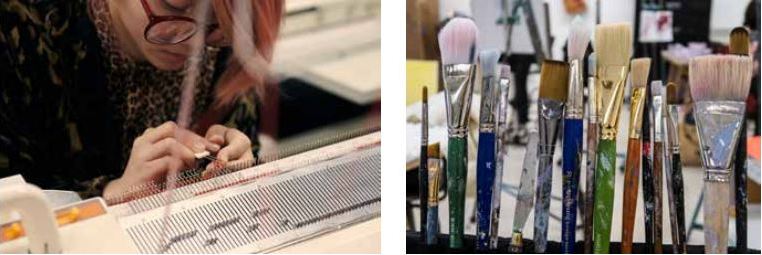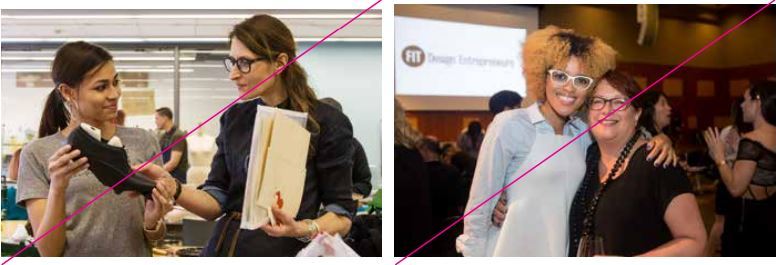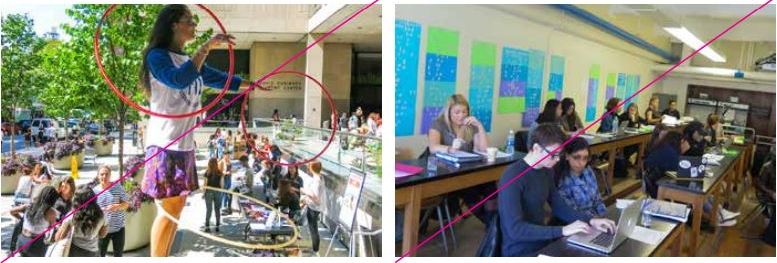Photography and Video
Photography is a key component in the college’s visual language. FIT imagery aligns with the brand voice showcasing an authentic feel, using rich color and, when possible, shot from an unexpected and unconventional perspective.
Communications and External Relations arranges photography needed for institutional communications. We also maintain a photography archive of major college events and activities, as well as a photo library of selected campus and classroom images that you can access for communications materials.
When organizing your own photography for any FIT materials, please follow the college's best practices below to ensure correct permissions are granted and all branding is aligned.
Services
We assign a photographer to shoot events and activities that we plan to cover for college media.
To find out if we will be covering your event, please make an inquiry. If we won’t be covering it, we can provide recommendations of freelancers and typical rates should your department want to hire a photographer.
Inquire about producing or filming a creative video
Communications and External Relations can help produce a video for you as part of
a larger marketing plan. We can also help point you to other campus video resources.
Record an event
Media and Event Technology Services provides filming of campus events. There are also
other options such as recording virtual events through Google Meet and Webex.
- Find all the details about Video at FIT and how the Gladys Marcus Library can archive your event video after you are done.
- You will also need to be sure to get signed video releases from participants.
Have more questions about getting a video filmed? Fill out our video inquiry form.
The college's photo library consists of selected images of:
- the campus
- faculty teaching in classrooms
- students in academic settings
- student life
- classrooms, labs, studios, and campus facilities
- special events
These images can be downloaded in high resolution for use in your FIT communications.
Click on "Galleries" in the top menu bar to view available photos.
If you need specialized images and are interested in viewing FIT’s photo archives or are looking for a specific image, make an inquiry using our Photo Request Form.
If you have specific questions about campus photography or would like more information on our best practices for photography, contact Smiljana Peros, Photography and Production Coordinator, at [email protected].
Photography Best Practices
Please be sure that you always ask consent from all parties before photographing them. Students sign a blanket photo release when they join FIT, but that only gives the college permission to take photos of them for academic and marketing purposes. Faculty and staff do not sign this blanket release and are therefore not included.
If you are photographing a large event, it may not be feasible to get signed releases from all attendees. In that situation, post a written notice at the venue entrance and, if possible, in the event’s printed program or in an on-screen slideshow prior to the event's start. Below is the appropriate text:
Attendees at this event may be photographed, filmed, and/or otherwise recorded. FIT reserves all rights afforded by law to utilize the footage for any lawful purpose.
People under the age of 18 are considered minors and cannot consent to be photographed without the permission of a parent. Please note that several students on FIT's campus are considered minors, especially participants in the college's Precollege Programs. Always ask permission to photograph students.
This is also a reminder to be aware of how minors are represented in photography. Please be mindful of how images may be cropped or misused.
Using exising imagery? You must secure written permission from the creator to use their work. You may also be asked to pay for the imagery. Please keep your own file of this permission and/or paid receipt for legal purposes.
Do not include any artwork, products, or spaces in your photographs without appropriate permission from their creators or owners.
Appropriately acknowledge sources and photographer/artist credits with accompanying text. Below is an example of a photo credit with the photographer's name that also acknowledges that a gallery shared the image with us:
Photo: Madison Sample, courtesy of Doe Gallery.
In spirit, content should represent FIT’s brand identity and un-words, for example—unlimited, unstoppable, unpredictable, unexpected, undeterred, uncommon, unbelievable.
Photos should:
- feel authentic, and captured in the middle of a moment, not overly staged.
- feel aspirational but attainable.
- feature shared experiences and interactions, never people obviously posing.
- represent diversity in gender, ethnicity, and age—though not to the extent that it misrepresents the college's actual demographics.
- feature real people of all shapes and sizes.
- reflect FIT”s modern and creative identity.
- strive for dynamic, artistic compositions rather than mere documentation
- use lighting and angles creatively, but avoid dramatic edits that could distort the subject or mood.
- be mindful of appropriation of culturally significant clothing, symbols, or practices.
- Shots of people interacting, photographed from an unexpected angle.
- Images with aspirational campus environment.
- Images that are rich in color.
- Shots with faculty and students engaged in real tasks.
- Students shown in authentic FIT environments.
- Active moments captured from an uncommon perspective.
- Make the action the focal point (students on campus and in classrooms, rather than a just scenic shot of the school areas).
- Candid, natural moments that convey authenticity and relatability.



- Shots that show the building in uncommon angles.
- Images that highlight the serenity of the campus within a bustling city environment.
- Campus shots that are stylized and unexpected.
- Show the creative and working environment of FIT.


- Detail shots of an action or task in progress.
- Close-up shots of materials and tools in use.
- Shots of students engaged in a specific activity.
- Details of the classrooms and student spaces.


- Don’t crop images too tightly or in a way that misrepresents the subject. Always include contextual elements (e.g. backgrounds or surroundings) when appropriate.
- Don’t use photos of staged interactions.
- Don’t use images with centered subject matter and obviously posing for the camera.
- Don’t show students outside their authentic FIT environment.
- Don’t highlight inauthentic group moments.
- Don’t use images with a busy background.
- Don’t use images that are dated and have artificially saturated color.
- Don’t use badly framed and lit compositions.
- Don’t include distracting elements like garbage cans, cables, empty water bottles or other cluttered objects.
- Don’t photograph individuals in revealing or minimal clothing, particularly during summer months.


DOWNLOAD FIT'S FULL BRAND IDENTITY GUIDELINES FOR PHOTOGRAPHY (.PDF)